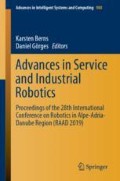Abstract
This paper aims to reduce gearbox errors on industrial robots with a feed forward, neural adaptive control. The algorithm combines two networks, one for control and one for system identification. In order to achieve a high precision and generality on untrained data, a Runge-Kutta Neural Network is used for black-box identification of a nonlinear robot joint. Secondary encoders as additional angle sensors measure the gearbox error and are used for supervised learning. The presented algorithm is capable of online application and reduces gearbox errors in a nonlinear simulation.
Access this chapter
Tax calculation will be finalised at checkout
Purchases are for personal use only
References
Abele, E. (ed.): Spanende Bearbeitung mit Industrierobotern: Forschungsprojekt ADVOCUT - Entwicklungen und Industrietransfer. Abschlußbericht BMBF-Verbundprojekt. Meisenbach, Bamberg (2007)
Thümmel, M.: Modellbasierte Regelung mit nichtlinearen inversen Systemen. Dissertation, Technische Universität München (2006)
Rösch, O.: Steigerung der Arbeitsgenauigkeit bei der Fräsbearbeitung metallischer Werkstoffe mit Industrierobotern. Dissertation, Technische Universität München (2015)
Uhlmann, E., Reinkober, S., Hollerbach, T.: Erhöhung der genauigkeit beim fräsen mit industrierobotern. ZWF Zeitschrift für wirtschaftlichen Fabrikbetrieb 113(9), 576–579 (2018)
Devlieg, R.: High-accuracy robotic drilling/milling of 737 inboard flaps. SAE Int. J. Aerosp. 4(2), 1373–1379 (2011)
Belz, S.: Nichtlineare Modellierung, flachheitsbasierte Vorsteuerung und abtriebsseitige Regelung eines Robotergelenkes. Technische Universität Kaiserslautern, Studienarbeit (2018)
Hagan, M., Demuth, H.: Neural networks for control. In: Proceedings of the American Control Conference (1999)
Polycarpou, M.M.: Stable adaptive neural control scheme for nonlinear systems. IEEE Trans. Autom. Control 41(3), 447–451 (1996)
Efe, M., Kaynak, O.: A comparative study of neural network structures in identification of nonlinear systems. Mechatronics (1998)
Wang, Y.J., Lin, C.T.: Runge-kutta neural network for identification of dynamical systems in high accuracy. IEEE Trans. Neural Networks 9(2), 294–307 (1998)
Deflorian, M.: Versuchsplanung und Methoden zur Identifikation zeitkontinuierlicher Zustandsraummodelle am Beispiel des Verbrennungsmotors. Dissertation, Technische Universität München (2011)
Suykens, J., Vandewalle, J.: Absolute stability criterion for a lur’e problem with multilayer perceptron nonlinearity. In: International Workshop on Nonlinear Dynamics of Electronic Systems (1996)
Reiner, M.: Modellierung und Steuerung von strukturelastischen Robotern. Dissertation, Technische Universität München (2010)
Kurze, M.: Modellbasierte Regelung von Robotern mit elastischen Gelenken ohne abtriebsseitige Sensorik. Dissertation, Technische Universität München (2008)
Suykens, J., de Moor, B.L.R., Vandewalle, J.: NLq theory: a neural control framework with global asymptotic stability criteria. J. Neural Netw. 10(4), 615–637 (1997)
Author information
Authors and Affiliations
Corresponding author
Editor information
Editors and Affiliations
Rights and permissions
Copyright information
© 2020 Springer Nature Switzerland AG
About this paper
Cite this paper
Weigand, J., Volkmann, M., Ruskowski, M. (2020). Neural Adaptive Control of a Robot Joint Using Secondary Encoders. In: Berns, K., Görges, D. (eds) Advances in Service and Industrial Robotics. RAAD 2019. Advances in Intelligent Systems and Computing, vol 980. Springer, Cham. https://doi.org/10.1007/978-3-030-19648-6_18
Download citation
DOI: https://doi.org/10.1007/978-3-030-19648-6_18
Published:
Publisher Name: Springer, Cham
Print ISBN: 978-3-030-19647-9
Online ISBN: 978-3-030-19648-6
eBook Packages: Intelligent Technologies and RoboticsIntelligent Technologies and Robotics (R0)

